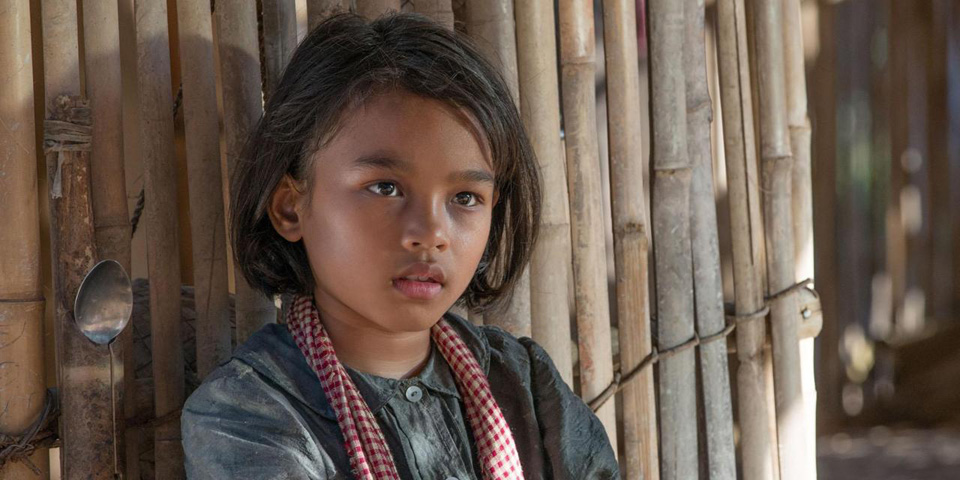
First They Killed My Father, directed by Hollywood movie star and activist Angelina Jolie, gives a first-person view of genocide and war through the eyes of a child. The two-hour-plus film is based on the bestselling memoir of the same name by Cambodian-born American human-rights activist, Loung Ung. It is a haunting tale of the mass killings in Cambodia brought about by the Khmer Rouge in the 1970s led by politician, Pol Pot, that has lasting lessons for humanity today. Through beautiful imagery, graceful performances, and the subtle exploration of terror and loss, the film does a fine job of humanizing a part of history that has often been overlooked in mainstream media.
Through the opening montage, director Jolie makes plain the hand that the United States government had in the Khmer Rouge’s rise to power. The song “Sympathy for the Devil,” plays in the background as snippets of former U.S. president Richard Nixon cut in and out over images of war and explosions. Nixon is heard saying that America is “helping the people of Cambodia to help themselves.” By the end of the montage, it is understood that the United States government has abandoned Cambodia, after heavily contributing to the disruption and violence plaguing the country. It is understood that many in Cambodia turned to the Khmer Rouge after years of resentment over U.S. intervention. From this point on, the camera is now set through the eyes, or closely around, a young Loung Ung, played by child actress Sareum Srey Moch. The year is 1975, and the young daughter of a high-ranking Cambodian government official will have her life forever changed from this point on.
The film relies heavily on the senses of sight and sound—focused on atmosphere rather than dialogue, which is minimal. The dialogue and credits are in the Khmer language, with English subtitles. We see through Loung Ung’s perspective how the vibrant colors of her childhood home, dresses, and city life quickly morph into the muted colors of blueberry-dyed peasant clothes and dirt floors. Like Loung Ung, we only hear snippets of dialogue of the adults around her, as she tries to understand the situation she has found herself in. This forces the audience to not get bogged down so much with the who and what of the civil war in Cambodia at that time, but rather focus on the suffering human characters caught up in its midst.
Although the film is a little over two hours long, it is not filled only with images of war and carnage. We also get moments of Loung Ung’s childhood imagination as it attempts to take her away from the bleak life she now lives, or other moments of her bonding with her siblings. Jolie has made sure to keep Loung at the center of the narrative, as to not get lost down the rabbit hole of sensationalist violence onscreen.
Today’s movie-going audiences are usually no strangers to blood and gore on their screens, to such a point that the consequences and weight of violence can become lost. Jolie strikes a balance by always reminding the audience that there is someone (in this case, Loung Ung) that is bearing witness to this violence, and who will be forever changed by it. It humanizes the tragedy, and forces viewers to not think of it as detached from themselves or their fellow humans. Through the graceful performances of the child actors and the adults, such as Phoeung Kompheak and Sveng Socheata as Loung’s parents, the struggle of the protagonist’s family to survive resonates deeply.
The one drawback of the film, and it is no fault of Jolie’s really, is that without the proper context, some viewers, not familiar with this aspect of history, may come away with some misguided conclusions. This is particularly the case with respect to the role of the Khmer Rouge organization and its leader, Pol Pot.
Throughout history, there have been many powerful men killing and subjugating people under the guise of some moral mission. Sometimes, it is has been religion, while at others it has been a governmental system or ideology, and the list goes on. While the faces and places change, the theme is consistent—that is, of someone claiming devotion to some ideal (be it socialism, communism, capitalism, democracy, nationalism, etc.) as a cover for pushing forward their agenda of totalitarian rule and greed. Corruption doesn’t discriminate and can infect anyone.
Pol Pot and his followers claimed to be communists. Through their violence and hate, they killed millions. They had a warped version of socialism which they forced upon the people of Cambodia. They claimed there would be no more classes and that everyone was equal, but of course, that was not true.
That does not mean though, that communism itself was the root cause of this evil—especially given it was the Communist-led government of Vietnam that eventually helped to liberate the Cambodians from the ruthless Khmer Rouge regime. History is nuanced, and at times complex. If nothing else, hopefully this film makes its viewers curious about this episode in history.
Another aspect of the film to note, is that there are no white saviors to be found in this story. Aside from Nixon, there are no major white characters to be found in the film at all. This is a narrative of a Cambodian child, her family, and her community. It is a universal tale of what war and corrupt regimes can do to a people, but it also serves as representation for a section of the population that lacks coverage in mainstream entertainment and media. Jolie, the Hollywood starlet, uses her platform and influence to put the spotlight on something other than herself.
At a time where a seemingly white supremacist with warmongering tendencies holds the highest office in the United States of America, a mainstream film that shows the struggles of people of color brought about by war, hate, and imperialism is important, perhaps now more than ever.
Cambodia has chosen First They Killed My Father as it’s Oscars submission for the Best Foreign Language Film, and rightly so. It’s a film that many should see, and take to heart. As the film aptly states; “A daughter of Cambodia remembers, so that no one can forget.”
First They Killed My Father is currently showing in select theaters across the country, and available for viewing on Netflix.










